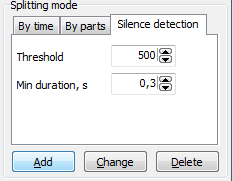This section covers one of the most exciting features of the Visual MP3 Splitter & Joiner. About splitting an audio file into a number of equal parts you can read in the section “Splitting Options”. Visual splitting is covered in “Visual Splitting of MP3 and WAV Files”.
Silence detection allows you to extract songs from a continuous recording and save them as separate tracks. Another example would be cutting some audio book: they often use large pauses between chapters. Yet another…
Well, you’ve already got the picture. So let’s move to the process.
First, you should load a file to split. We’ve seen how to do this in a previous section.
Then switch to the “Silence detection” tab on the right pane. Here you can see only three options: ‘Threshold’, ‘Min duration, s’, and ‘Add silence to split list’. For typical uses the default values are good. However if you need something special, you may want to play with them.

To detect parts with silence detection, simply click on the “Add” button. After processing your file the program puts the parts that it has found into split list. Now you can edit them, or simply click on the “Split” button to end it on this, or save a CUE-Sheet file. Pretty easy, isn’t it?
Let’s take a look at advanced options. ‘Add silence to split list’ means that silent parts won’t be thrown away. When this option checked, the program saves a silent part of your audio file just like any other part of the recording, in a separate file. Not a second is lost. Sometimes this may be useful, for instance, if ‘silent’ parts are not completely silent, or if you need to preserve the duration.
‘Min duration, s’ sets minimal duration of silence when the program starts to react on it. There can be silent moments inside a song that are much shorter than silence between tracks, and you may want to extract the song as a whole. Or in audio books silence between chapters is longer than usual ‘take a breath’ silence. You can set accuracy to tenth of a second.
‘Threshold’ is actually a level of noise which the program takes for silence. Silent parts are not always completely silent. There can be some ‘hum’, especially if you recorded some lecture. Quiet classics demands a lower threshold value (about 100), some noisy recording may take 1000 to be split successfully. Usual value is between 100 and 500.
 en
en Italian
Italian German
German French
French Spanish
Spanish Russian
Russian